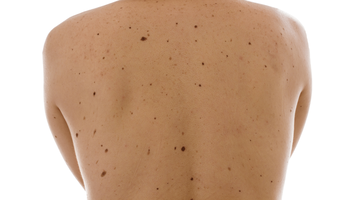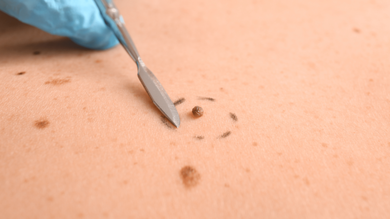Mole Removal Near Me: Everything You Need To Know

It is the spot or blemish that has been bothering you for a long time—your mole. Moles can appear almost anywhere on your body (even under your fingernails), and sometimes, you wish they went away. For health or beauty reasons, you may be searching for “mole removal near me.” For beauty reasons, moles are easy to remove with several painless options. And for health reasons, removing potentially cancerous ones could be life-saving. Here’s everything you need to know about your mole, what happens during mole removal, and how to find a mole removal expert.
What are moles?

Our skin has special cells called melanocytes. Melanocytes live at the basal layer of the epidermis and give us our skin color by producing and containing melanin. More importantly, they protect our skin from the harmful UV rays from the sun. We all have the same number of melanocytes. However, people with darker skin produce more melanin.
These melanocytes tend to grow in clusters, and some can gather at the top layer of the skin, creating dark spots called moles.
Moles are often flesh-colored, deep brown, or black and are sometimes raised. Some are present at birth (congenital nevi), but most appear later in childhood and early adulthood due to genetics and excessive sun exposure.
Some women tend to get more moles during pregnancy thanks to changes in hormones.
Moles tend to last about 50 years, varying in size and shape. Most moles are harmless, painless, and non-contagious, with many considered beauty marks. However, larger ones in specific areas may feel unsightly while others can change (atypical moles), developing into dangerous cancers.
Is your mole cancerous?
Skin cancer is one of the most common forms of cancer, with 1 in 5 Americans at risk. One such type of skin cancer is melanoma, which starts in the same melanocytes that form moles. Don’t worry. Only 1% of skin cancers stem from melanoma. In fact, most moles are harmless, with a small percent of moles tested considered cancerous. That said, cancerous moles are dangerous since they are detected late. These cancers can spread to other organs, making them much more deadly.
Cancerous moles are easier to detect using the rule of ABCDE:
- Asymmetry: Is one half larger/smaller than the other?
- Border: Do the edges of your mole look jagged or out of the ordinary in any way?
- Color: Has the color of your mole changed over time? Is it now red, pink, brown, or blue?
- Diameter: If it has grown over time, you should consider visiting your dermatologist.
- Elevation and Evolution: Did your mole move from flat to raised? Has it evolved into something else in a brief time?
Look for other signs like bleeding, itching, swelling, pain, or an unusual discharge. If you have multiple moles, it is vital that you perform self-checks in the mirror at home. These can be done occasionally but should increase to monthly if your family has a history of skin cancer or you have battled skin cancer in the past.
Are mole removals necessary?
Mole removals are usually unnecessary, but some patients prefer removal for cosmetic reasons. For instance, the mole may hamper someone’s appearance for work or personal endeavors. Others may have dealt with a mole in an unwanted place (like the face) and are finally in a financial or emotional position to get rid of it. These cosmetic reasons will be discussed with your doctor.
If the mole does show signs of melanoma (following the ABCDE rule), removal is necessary once confirmed with a biopsy. A biopsy takes a sample of the mole to send for lab testing. The lab confirms if the mole is cancerous and if removal is necessary.
Is it safe to remove yourself?
There are different DIY methods, devices, and techniques to remove moles without medical intervention. These at-home devices or DIY methods pose threats to the health of your skin.
You run the risk of infection if the mole removal is not done under the supervision of your doctor. The infection can lead you to a doctor as it will not heal the way you intended. That means more expenses in antibiotics and even misdiagnosis of melanoma.
You can also cause long-term scarring, like an indentation caused by cystic acne, if the removal is done incorrectly.
Most of all, you could be removing a potentially dangerous melanoma. The surrounding skin cells could still be cancerous, leading to a potentially dangerous situation. Removing a cancerous mole sometimes involves removing the surrounding skin cells to prevent cancer from spreading.
Sometimes, you can accidentally scratch or pull on your mole, causing bleeding. The skin may be broken below the mole, but this is not a sign to remove it yourself. You can treat the mole at home like you would a regular cut. Clean the area with a saline solution or rubbing alcohol. Apply a cotton ball to remove debris, then cover with a clean bandage. If the mole keeps bleeding, seek your dermatologist’s help immediately.
Looking online for a ‘mole removal near me’ option is much smarter than looking for mole removal tools to do it yourself. Your dermatologist has a deeper understanding of your mole and the best treatment options. If they suspect the mole is cancerous, they will perform a biopsy first, then take action.
Types of mole removals

If the best course of action is to remove the mole, there are a few treatments available. At Eternal Dermatology + Aesthetics, we provide all up-to-date medical techniques in a safe, comfortable environment. Some patients require multiple removals, while others need one atypical mole removed. Most procedures are painless, minimally invasive, and require little downtime.
If your dermatologist confirms that removal is possible, the process takes less than an hour and can be done on your lunch break or weekend.
Excision surgery
Surgery is the most common form of mole removal. It’s a non-invasive procedure where your dermatologist cuts away the mole and part of the skin with a scalpel. Before cutting away the mole, the dermatologist will inject an anesthetic into the mole. After removing the mole and skin, your dermatologist will close the incision with stitches. Excision is one of the best ways to
Shave removal surgery
With shave removal surgery, your dermatologist uses the scalpel but takes a different approach. The doctor uses the scalpel to shave off layers of the mole until it’s removed completely. Instead of an injected anesthetic, your doctor will use a topical anesthetic. While the shaved method requires no stitches, there is a greater possibility of regrowth.
Cryotherapy
Cryotherapy is a popular removal form, particularly for raised, non-cancerous moles. The process is sometimes called cryosurgery and uses liquid nitrogen to ‘freeze’ off the mole. The liquid nitrogen can go as low as minus 196 degrees to destroy the skin cells. Then, the dermatologist applies the liquid nitrogen to the mole with a cotton swab. Cryotherapy can be slightly painful and leave a scar or slight discoloration. Your dermatologist will determine if the procedure is right for you.
Laser therapy
Flat, non-cancerous moles can be tricky to remove. With laser therapy, dermatologists can clear up these moles. The doctor uses a wand that emits Intense Pulsed Light to break up the cells and tissues. Over 2-3 sessions, the cells are completely destroyed, and the mole removed. Lasers are great for small moles in hard-to-reach areas and require no downtime.
Electrodissection
An electrical current through a special device is another effective mole removal option. Your dermatologist will apply the current to the moles, eventually destroying the cells and drying out the mole. Like laser therapy, electro dissection may happen over multiple procedures. Electrodissection is popular for its minimal pain and scarring.
Mole removal aftercare
After your procedure, there should be no downtime so that you can go back to work right away. Scratching and soreness are common during the first week as the skin heals. Keep the area clean, dry, and moisturized for at least 24 hours. If you had excision surgery, gently clean around the area without impacting the sutures. Avoid sweat or strenuous activity for at least 24 hours as well.
Your dermatologist may call you 1-2 weeks after your procedure to share the results of any biopsies and to check on the healing process. If necessary, the surgeon will also remove stitches. In about 2-3 weeks, you should see the full results of the procedure in 3-4 weeks.
Do moles grow back?
Removing moles can bring the desired results patients crave from a beauty perspective. Mole removal also lessens the chances of developing skin cancer, especially if the dermatologist suspects the mole is cancerous. However, some patients are concerned that their moles will return.
If it’s a large mole in a conspicuous spot, they may be scared the mole returns.
For cancerous moles, there is a risk of developing cancerous moles again.
If a mole returns are often dependent on the type of procedure used by your dermatologist. Mole shaving, for instance, has a higher chance of regrowth since there are cells left behind. With freezing, some moles can return if there are skin cells that were not treated during the procedure. Lasers and surgical incisions are much more effective since it removes some of the surrounding skin.
If you notice your mole returning, speak with your dermatologist right away. The next step would be to move to a surgical incision, a near-permanent solution to mole removal.
How to find mole removal near me
If you want your mole removed for cosmetic purposes or suspect a cancerous mole, it’s important to find a trusted dermatologist that can help. You can search for ‘mole removal near me’ or a ‘dermatologist near me’ in your local search. Take a look at patient reviews before choosing a dermatologist that specializes in mole removal.
You’ll be surprised to find that some mole removals are covered by insurance. If the procedure is necessary to prevent skin cancer or for testing purposes, your insurance provider may cover your treatment. On the flip side, if it is strictly for cosmetic purposes, the procedure will not be covered. It’s essential to find a dermatologist who understands how insurance works for these treatments.
At Eternal Dermatology, we do an initial consultation to assess your moles and understand your concerns. If necessary, we will take a biopsy before moving on to mole removal. We will perform the best procedure that is painless, leaves minimal scarring, and provides long-term results.
Let us help clear your mole.
As we age, we develop our fair share of moles, especially if we’re exposed to excess sunlight. Sometimes, these moles develop in areas that we don’t like. More importantly, if the shape, size, and color change, there could be dangerous skin cancer at play. Both are great reasons for mole removal, but you should proceed with caution. Do not attempt to remove the mole yourself. Speak with a board-certified dermatologist. In some cases, your dermatologist can become a lifesaver by intercepting a dangerous melanoma.
If you’re looking online for “mole removal near me” and you’re in the DC area, you’ll come across Eternal Dermatology +Aesthetics. Our team, led by dermatologist Dr. Ife Rodney, specializes in skin care procedures, including mole removal. We provide all available removal options and perform all therapies in a safe, comfortable environment.
Reach out to our team to schedule a consultation today. We are located in Fulton, MD, and proudly serve patients in Columbia, MD, Clarksville, Ellicott City, Laurel, Bowie, Silver Spring, and surrounding areas in PG and Howard County, Maryland.
